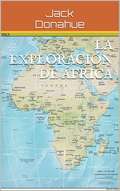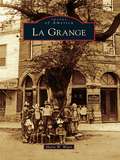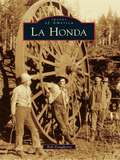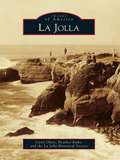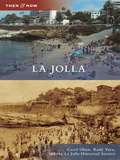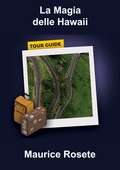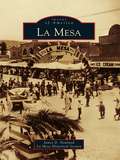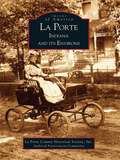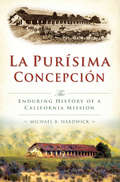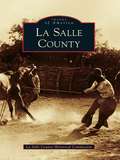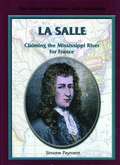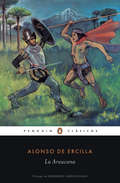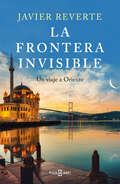- Table View
- List View
La Dolce Vita University: An Unconventional Guide to Italian Culture from A to Z
by Carla Gambescia<p>La Dolce Vita University (LDVU) is the perfect sampler for anyone curious about (or already in amore with) Italy and its remarkably rich cultural gifts, both past and present. True to its lighthearted name, La Dolce Vita "U" is all about pleasurable learning, or what we prefer to call "edu-tainment." Its dozens of entertaining yet authoritative mini-essays on a wide assortment of intriguing topics encourage random dipping at the reader's pleasure. Even the most erudite Italophile will discover fun new facts and fascinating new insights in the pages of La Dolce Vita U. <p>Mini-essays treat specific topics in one or more of the following subject areas: the Italian character; the visual arts (art, artists, architects); the performing arts (music, theater, cinema); history and antiquity; language and literature; cuisine and agriculture; wine and spirits; traditions and festivals; style and applied arts; unique places. In a wink and nod to the book's "academic" identity, the 165 mini-essays are arranged alphabetically and accompanied by charming illustrations throughout. A special traveler's topic index is provided at the end of the book.</p>
La Exploración de África
by Diana Rodríguez González Jack DonahueNo hace mucho, el interior de África era un libro cerrado para el mundo civilizado. Los mapas presentaban una terra incognita, o montañas estériles, donde los viajeros modernos han hallado ríos, lagos y cuencas aluviales, o exhibían páramos yermos donde, según descubrimientos recientes, hay praderas surcadas anualmente por arroyos, salpicadas de ciudades y poblados amurallados, animadas por rebaños de ganado o con cultivos en plantaciones de maíz y algodón. Jack Donahue nos guía hasta la Edad de la Exploración de África, a mediados del siglo XIX, con relatos en primera persona de los que estuvieron allí.
La Face Cachée de Disney
by Leonard Kinsey Raphaël GarroutyLA FACE CACHÉE DE DISNEY vous révèle tous les trucs, toutes les astuces, toutes les combines et toutes les histoires que l'on veut vous cacher ! Sans jamais craindre de choquer le public familial auquel s'adressent les autres guides de voyage Disney, Leonard Kinsey livre aux routards intrépides les dessous sulfureux, peu reluisants et souvent cocasses de Walt Disney World. Du trafic de billets à l'exploration sauvage, en passant par la plus totale débauche, ce guide non-autorisé vous fera voir autrement « l'endroit le plus joyeux du monde ».
La Grange (Images of America)
by Marie WattsLa Grange, voted the capital of the Republic of Texas in 1838, is as colorful and audacious as the state itself. Its citizens were instrumental in winning the republic's freedom and have always been willing to fight for their beliefs. Many defend La Grange as the true capital of Texas, unfairly stripped of its title. The town flourished during the 19th century and witnessed the birth of a rough-and-tumble society, where arguments were commonly settled with fists, knives, and guns. In later years, immigrants flocked to the area and built a strong agricultural economy. The 20th century might have passed quietly into history if not for a Houston television reporter who publicized the demise of one of Texas's best-known brothels, the Chicken Ranch, located just outside of La Grange. The extensive publicity surrounding the closing of the "Best Little Whorehouse in Texas" resulted in a musical and movie of the same name, as well as a song by ZZ Top.
La Guida Suprema per fare Campeggio: lista di controllo completa & guida sugli accessori
by John JohnsonVuoi avventurarti in campeggio? Ti piacerebbe imparare come fare camping come fanno i professionisti? Se hai risposto sì a queste domande, questo libro fa per te. Scopri come iniziare e tutto ciò che devi sapere sullo sport e come fare camping come un professionista. Verranno presentati i prodotti che i professionisti usano per scalare i terreni più difficili! Con decenni di strategie testate, questo ebook ti mostrerà il modo più veloce ed efficace per imparare a fare camping! Cosa è incluso: - Come iniziare. - Liste di controllo. - Quali attrezzi usare. - Come fare camping. - Preparazione. E MOLTO ALTRO! Se vuoi essere più forte ed efficace nel camping, allora questa guida è per te. -> Scorri fino all'inizio della pagina e fai clic su Aggiungi al carrello per acquistare immediatamente Dichiarazione di responsabilità: Questo autore e / o il / i proprietario / i dei diritti non fanno rivendicazioni, promesse o garanzie in merito all'accuratezza, completezza o adeguatezza dei contenuti di questo libro e declinano espressamente la responsabilità per errori e omissioni nei contenuti all'interno. Questo prodotto è solo per riferimento. Si prega di consultare un professionista prima di agire su uno qualsiasi dei contenuti presenti all'interno.
La Guía Definitiva de Acampado: Lista Completa de Equipamiento y Accesorios
by John Johnson¿Estás buscando iniciarte en el arte de acampar? ¿Quieres aprender a acampar como lo hacen los profesionales? Si respondiste si a estas preguntas entonces este libro es para ti. Aprende como comenzar y todo lo que necesitas saber sobre acampar como lo hacen los profesionales. Usar estas técnicas y tips de acampado te ayudará a empezar y acampar mejor que nunca antes! Presentamos los secretos que los profesionales usan para escalar los terrenos más difíciles. Con décadas de estrategias comprobadas, este ebook te mostrará la forma más rápida y efectiva para aprender este deporte! Que incluye: - Empezando - Lista esencial - Que equipamiento usar - Como acampar - Preparaciones + MUCHO MÁS! Si quieres ser mejor y más efectivo a la hora de acampar, esta guía es para ti. --> Sube al principio de la página y haz click en el carrito para comprarlo inmediatamente Información Legal: Este autor y/o los dueño/s de los derechos no hacen declaraciones, promesas o garantías en referencia a la precisión, integridad o adecuación del contenido de este libro y expresamente renuncian a la responsabilidad por errores y omisiones en el contenido interno. Este producto es para uso de referencia unicamente. Por favor consulte a un profesional antes de tomar acción sobre cualquiera de los contenidos que se encuentran dentro.
La Honda
by Bob DoughertyLess than 45 miles from San Francisco and Silicon Valley, La Honda is an isolated rural community nestled in the majestic coastal redwood forests of the Santa Cruz Mountains. Pioneers in the late 19th century were loggers and ranchers who competed against grizzly bears and mountain lions for food. Outlaws like the Younger brothers (partners with Jesse James) used La Honda's isolation to avoid justice. Gradually the community became a mountain retreat for cityweary San Franciscans, and in the 1960s, La Honda was home to One Flew Over the Cuckoo's Nest author Ken Kesey and his psychedelic Merry Pranksters. Today's La Honda is an enigma--its size and character have barely changed while the rest of the San Francisco Peninsula has exploded around it.
La Jolla
by Carol Olten Heather Kuhn La Jolla Historical SocietyLa Jolla, California, famously known as "The Jewel," is noted for its natural beauty and appealing Mediterranean-like climate. Magnificent sea cliffs and caves, bathing coves, and sandy beaches have attracted visitors, developers, and residents since the 1880s. By the early 1900s, a small community developed with artists congregating to the internationally known Green Dragon Colony. Newspaper heiress Ellen Browning Scripps and her half-sister Eliza Virginia established residences and became the community's renowned philanthropists. Many beautiful homes and institutions, along with a growing commercial district next to the sea, owe their designs to architect Irving Gill. Today La Jolla still attracts visitors from around the world and is home to the rich, the famous, the avant-garde, and intelligentsia.
La Jolla
by Carol Olten La Jolla Historical Society Rudy VacaBeginning with its first settlement in the 1880s, La Jolla established its reputation as a Southern California seaside community known for incredible beauty and natural wonders, shores washed by the surf of the Pacific, and hillsides by jagged sandstone cliffs rising from the sea. Artists, architects, and an incredible philanthropist (Ellen Browning Scripps) were attracted to the community early on. Later came fantastic growth and change.
La Magia delle Hawaii: Guida turistica per le isole Hawaii ricca di siti da visitare e consigli da seguire
by Maurice RoseteFantastica guida turistica delle Hawaii! Scoprite i cento luoghi migliori da visitare sulle isole di Oahu (la capitale), Maui, Kauai e delle Hawaii. Se state per per visitare o trasferirvi alle Hawaii, dovete assolutamente leggere questa guida colorata che vi farà perdere la testa. La guida è ricca di idee e soluzioni per il ventunesimo secolo. Imparate a conoscere la cultura hawaiana, incontrate la gente del posto che rende questo luogo così speciale e preparate a diventare una famiglia nel rispetto di una cultura diversa e delle persone che la caratterizzano, i "Kanaka Ole". Imparate la vera storia delle isole Hawaii a partire dalla nascita del regno sotto la dinastia di Kamehameha . Non troverete una guida migliore. Godetevi il viaggio e saziate la vostra sete di curiosità, conoscenza e onestà.
La Mesa
by James D. Newland La Mesa Historical SocietyOn February 16, 1912, La Mesa Springs, a community of 700 citrus farmers, home seekers, developers, and businessmen, incorporated into the City of La Mesa. Located amongst the rolling hills and mesa lands between San Diego and El Cajon, today's suburban city of over 56,000 is still renown for its small-town character, featuring its historic "village" business district, family-friendly neighborhoods, good schools, and ample retail and recreational amenities. The area's centuries-old prehistory and history can be traced to the natural springs that attracted stockman Robert Allison in 1869. Allison Springs, later renamed, prospered and grew after the arrival of the railroad in 1889. After incorporation, the young city grew steadily, reaching 3,925 residents by 1940. Post-World War II La Mesa exemplified the exponential suburban growth of the region, expanding to the north and west of the old downtown to accommodate 50,000-plus residents by 1980--all were attracted, as today, to the "Jewel of the Hills."
La Passione: How Italy Seduced the World
by Dianne HalesFrom the New York Times bestselling author knighted by the President of Italy for her writing, a jubilant exploration of how Italy transformed the Western world's most vibrant passions -- from literature to art, music to movies. No country has matched Italy’s impact on culture. Just think of painting without Leonardo, opera without Verdi, fashion without Armani, food without the signature tastes of pasta, gelato, and pizza. The first universities, first banks, first public libraries? All Italian. Dianne Hales attributes these landmark achievements to la passione italiana, a primal force that stems from an insatiable hunger to discover and create; to love and live with every fiber of one's being. This fierce drive, millennia in the making, blazes to life in the Sistine Chapel, surges through a Puccini aria, deepens a vintage Brunello, and rumbles in a gleaming Ferrari engine.Our ideal tour guide, Hales sweeps readers along on her adventurous quest for the secrets of la passione. She swims in the playgrounds of mythic gods, shadows artisanal makers of chocolate and cheese, joins in Sicily’s Holy Week traditions, celebrates a neighborhood Carnevale in Venice, and explores pagan temples, vineyards, silk mills, movie sets, crafts studios, and fashion salons. She introduces us, through sumptuous prose, to unforgettable Italians, historical and contemporary, all brimming with the greatest of Italian passions—for life itself.A lyrical portrait of a spirit as well as a nation, La Passione appeals to the Italian in all our souls, inspiring us to be as daring as Italy’s gladiators, as eloquent as its poets, as alluring as its beauties, and as irresistible as its lovers.
La Porte, Indiana and Its Environs
by Archival Preservation Committee La Porte County Historical Society, IncOriginally part of the Pottawatomie Nation, the northern Indiana area of La Porte, which is French for "The Door," was named for the access it provided settlers who passed westward into the Calumet River valley. Now known as "The Maple City" for its many beautiful and colorful trees, La Porte boasts a rich and varied history. From its beginnings in 1833 when the city's founding fathers donated the land for the public square, through the 1930s and beyond, La Porte has been central to the area's business, agricultural, religious, and architectural development.The diverse and rich history of the La Porte area is captured in this remarkable collection of over 200 vintage photographs. La Porte, Indiana and Its Environs depicts the history of the area from the Pioneer Period through the 1930s. It chronicles the changes and challenges faced as the log cabins of the Pioneer Days became the elaborate homes of the early 20th century, as businesses evolved to meet the changes of industrialization, and as one-room school houses were replaced to meet the needs of the growing community.
La Primera: The Story of Wild Mustangs
by Ian TysonIan Tyson's classic song, beautifully illustrated for horse-loving youngsters everywhereThe story of the wild mustang in North America is the subject of “La Primera,” a song written and performed by Canadian folk singer and horse afficionado, Ian Tyson. And it is the subject of this handsome picture book with paintings by equine artist Adeline Halvorson. In 1493, the first Spanish horses were loaded onto a ship and taken on a long, hard voyage to the Americas. Many died along the way and only a few survived. Among them was La Primera. Little by little, their numbers grew, and in time they were in Mexico with Cortez and his conquistadors, on the grasslands with the Comanche upon their backs, and in frontier towns serving the needs of cowboys. The rugged wild mustangs still exist, and their bloodlines are traceable all the way back to those first horses and the careful records the Spaniards kept. That the animals have survived for five hundred years, while the world around them changed, is a tribute to their endurance and fiery spirit. Included with the story of the song is a section of historical facts on these amazing and beautiful animals and a CD of Ian Tyson singing “La Primera.”
La Purisíma Concepción: The Enduring History of a California Mission (Brief History)
by Michael R. HardwickIn two centuries, La Purísima Concepción went from a fledgling frontier mission to a renowned California State Historic Park. Once home to many Spanish soldiers, settlers and hundreds of Chumash Indians, La Purísima held the seat of the California Mission government under Father Mariano Payeras. It withstood catastrophic events, including widespread disease in early years and a great Southern California earthquake in 1812. Emerging from ruins for the last time in 1934, after restoration by the Civilian Conservation Corps, structures appear today as they did in the early nineteenth century. The uniquely restored California Mission complex operates as a state park in a pastoral setting. Author and archivist Michael R. Hardwick chronicles the story of La Purísima and the resilient people and culture that made a lasting influence.
La Salle
by Kristin PetrieThis biography introduces young readers to the life of Frenchman René-Robert Cavalier de La Salle. Readers learn about La Salle's childhood, education, and family life in France as well as his time in New France as a farmer and a fur trader. La Salle's exploration of the Ohio River for New France's governor Daniel de Rémy, Sieur de Courcelles is discussed. Also introduced is Jacques Marquette and Louis Jolliet's exploration of the Mississippi River during La Salle's time. Readers discover that King Louis XIV of France granted La Salle permission to explore western New France. And using a detailed map, readers follow La Salle's path through Lakes Ontario, Erie, Huron, and Michigan; his stops in present-day Green Bay, Wisconsin, and St. Joseph, Michigan; and his trips down the Kankakee, Illinois, and Arkansas rivers to the Gulf of Mexico. The book explains that La Salle was the first European to explore the length of the Mississippi River, he claimed the entire Mississippi River basin for France, and that the United States bought this territory from France in an agreement called the Louisiana Purchase. Full-color photos, an index, a timeline, discussion questions, bold glossary terms, and phonetics accompany easy-to-read text.
La Salle County (Images of America)
by La Salle County Historical CommissionThe Nueces River runs west to east across La Salle County, and at one time it served as the boundary between Texas and Mexico. The Treaty of Guadalupe Hidalgo, signed in 1848, ceded the Nueces Strip to Texas. La Salle County was formed out of some of this land in 1858. Early settlers struggled to survive in the wild terrain amid fears of attacks from outlaws and natives. From the Indian Raid of 1878 and the assassination of a sheriff, to droughts and dust storms, the hardy people of La Salle County persevered. After an election in 1883, Cotulla was selected as the permanent county seat, a courthouse was erected, and churches and schools were built. The lawlessness of the past is gone, but the county's residents share the perseverance of those early pioneers.
La Salle: Claiming The Mississippi River For France (The Library Of Explorers And Exploration Series)
by Simone PaymentRene-Robert Cavalier, Sieur de La Salle devoted his life to the discovery and exploration of the Mississippi River. He believed that the great river would provide him with an easier route to China, where he could find valuable silks and spices. His revised goal was to create a French empire in North America that would stretch from Canada to the Gulf of Mexico. This book follows La Salle on his tireless expeditions and teaches readers the value of persistence even when no one else believes in the cause.
La Vie en Rose
by Jamie IveyIn Jamie Ivey's sequel to Extremely Pale Rosé, he finds out whether it is possible to run a successful rosé bar in France. French friends think it's a crazy idea: bar customers are largely men and rosé is seen as a woman's drink; rosé is a seasonal drink and Jamie's trade will vanish come September - and rosé isn't supposed to accompany food. Yet France seems to be on the brink of a rosé revolution: rosé sales are booming. If Jamie can find a small bar in a pretty square and chalk up a selection of different rosés, a rosé bar could be a great success. Bars in Uzes, Aix en Provence and Nimes agree to help Jamie sell some rosé, and he discovers what the French attitude to rosé really is. Are gnarled old men discarding their pastis and sipping pale rosé? Is it just a myth that the French don't drink rosé with food? Are the young the real reason for booming sales? For readers who enjoyed Extremely Pale Rosé, and envied Jamie and Tanya Ivey's researches, La Vie En Rose is the perfect second glass.
La Vie en Rose
by Jamie IveyIn Jamie Ivey's sequel to Extremely Pale Rosé, he finds out whether it is possible to run a successful rosé bar in France. French friends think it's a crazy idea: bar customers are largely men and rosé is seen as a woman's drink; rosé is a seasonal drink and Jamie's trade will vanish come September - and rosé isn't supposed to accompany food. Yet France seems to be on the brink of a rosé revolution: rosé sales are booming. If Jamie can find a small bar in a pretty square and chalk up a selection of different rosés, a rosé bar could be a great success. Bars in Uzes, Aix en Provence and Nimes agree to help Jamie sell some rosé, and he discovers what the French attitude to rosé really is. Are gnarled old men discarding their pastis and sipping pale rosé? Is it just a myth that the French don't drink rosé with food? Are the young the real reason for booming sales? For readers who enjoyed Extremely Pale Rosé, and envied Jamie and Tanya Ivey's researches, La Vie En Rose is the perfect second glass.
La Vie en Rosé
by Jamie IveyIn Jamie Ivey's delightful sequel to Extremely Pale Rosé, he attempts what seems the impossible—running a successful rosé bar in France. French friends laugh heartily and say it's the silliest idea they've ever heard! Why, the customers for bars are mostly men and rosé is seen a woman's drink; not to mention, it's a seasonal drink and his trade will vanish come September! Then as if that wasn't enough, bars make their money from food, rosé isn't meant to accompany food. It's flat out preposterous. But Jamie looks at the entire scheme through rosé tinted glasses, and the idea proves irresistible. In spite of everything, rosé sales are booming in France and the sales of reds and whites have grown stagnant. If Jamie can just find that perfect bar, in a pretty square, and chalk up a daily selection of different rosés, the bar could be a great success. In a charmingly misguided journey that takes Jamie from Aix to Uzés and from Cannes to Juan Les Pins, he visits some of the eccentric yet wise vingerons from his previous journey and discovers what the French attitude to rosé really is. Are gnarled old men discarding their pastis and sipping pale rosé? Is it just a myth that the French don't drink rosé with food? Are the young the real reason for booming sales? Before he knows it, he has found the perfect bar hidden in the hills of the Luberon, and will do it up over the winter months. For all who enjoyed Extremely Pale Rosé, and envied Jamie's candidly hilarious adventures, La Vie En Rosé is the perfect second glass.
La araucana
by Alonso De ErcillaPublicado entre 1574 y 1598, el poema épico de Alonso de Ercilla es el testimonio en primera persona de los inicios de la guerra de Arauco, en Chile. Publicado entre 1574 y 1598, el poema épico de Alonso de Ercilla es el testimonio en primera persona de los inicios de la guerra de Arauco, en Chile. Escrito en octavas reales durante la estancia de Ercilla en el país, en los comienzos del conflicto de los conquistadores con el pueblo mapuche, se relatan los hechos previos a la llegada del autor al país y luego la participación del autor en la misión de conquista de la Araucanía chilena. Escritas en papel y cortezas de árbol en medio del conflicto, Ercilla fue narrando cada noche lo que sucedía: entre otras cosas la ejecución de Pedro de Valdivia, la historia de los caciques mapuches Lautaro, Fresia, Colo Colo y Caupolicán. La crítica ha dicho... "La araucana es uno de los tres mejores libros que, en verso heroico, en lengua castellana están escritos, y puede competir con los más famosos de Italia: guárdense como las más ricas prendas de poesía que tiene España". Miguel de Cervantes (en El Quijote)
La frontera invisible: Un viaje a Oriente
by Javier ReverteEl último viaje de Javier Reverte ¿Dónde se encuentra la línea que separa Asia de Europa? ¿Dónde comienza Oriente entendido como geografía y como sentimiento? Javier Reverte escogió esa frontera vaporosa y vulnerable, la más antigua del mundo, para realizar su último viaje. Eligió como puerta de entrada Estambul y su magnífico estrecho del Bósforo para después adentrarse en tren hasta remotas tierras iraníes. El resultado es un recorrido hermoso y nostálgico que se detiene tanto en las páginas de la historia antigua -tras la fulgurante estela de Alejandro Magno- como de la contemporánea -las guerras y revoluciones que marcaron el convulso siglo XX-, y que nos recuerda por qué Javier Reverte fue el mejor escritor de literatura de viajes en lengua castellana. Quería ir a Oriente Próximo, una región cuyo nombre resuena a inmensidad, ancianos imperios, guerras estremecedoras, ejércitos perdidos, ciudades enterradas, religiones muertas, viejas lenguas enmudecidas; también a pogromos y genocidios, sanguinarios sultanes, guerreros feroces y reyes belicosos, y junto a todo ello, a sensualidad, aventura y poesía. Javier Reverte
La historia del mundo en 100 objetos
by Neil MacgregorEste libro ofrece un enfoque único de la historia de la humanidad a través del estudio de objetos que las distintas civilizaciones, a menudo sin pretenderlo, han ido dejando a su paso. Estas obras se convierten en una suerte de prismas a través de los cuales podemos explorar mundos antiguos y conocer algo más sobre las vidas de los hombres y mujeres que los habitaron. El campo de estudio que abarca es enorme, comienza con el primer objeto fabricado por manos humanas que se conserva, una herramienta para cortar procedente de la Garganta de Olduvai, en África, y termina con un objeto del siglo XXI que representa el mundo en el que vivimos hoy en día.El propósito de Neil Mac Gregor no es ofrecer una mera descripción de estos valiosísimos objetos sino mostrarnos su significado: cómo una columna de piedra nos habla sobre un gran emperador indio que predicaba tolerancia a su pueblo, cómo monedas españolas de ocho, acuñadas en Potosí, nos explican los orígenes de una moneda global, o cómo un juego de té de la época victoriana nos revela cuál fue la importancia del imperio.Cada capítulo sumerge al lector en una civilización pasada y lo acompaña con una guía de excepción. Vista de este modo, la historia es un caleidoscopio, cambiante, interrelacionado, sorprendente, que configura nuestro mundo contemporáneo de un modo que la mayoría de nosotros nunca habríamos imaginado. Un festín para el intelecto y para la vista, uno de los libros de historia más originales y fascinantes que se han publicado en años.
La història de Barcelona en 10 passejades: Des dels romans fins a l'actualitat
by Jaume Grau MasbernatDes de la ruta de l'aigua, de les revoltes, de les guerres o de les epidèmies fins a la ruta del treball, de les obres i especulació o la Barcelona màgica, Jaume Grau ens convida a caminar per la ciutat per descobrir tota la seva història. La millor manera de conèixer Barcelona és caminant-la. En els seus carrers i places hi ha escrita tota la seva història i només cal obrir bé els ulls per descobrir-la. La Barcelona d'avui és el testimoni viu de les Barcelones d'ahir, i en les seves pedres ha quedat imprès un relat històric apassionant. Les deu rutes temàtiques que proposa Jaume Grau per recórrer la ciutat es poden fer caminant, cadascú seguint el seu pas, o, fins i tot, dissenyant el seu propi trajecte. Des de la ruta de l'aigua, de les revoltes, de les guerres o de les epidèmies fins a la ruta del treball, de les obres i de l'especulació o de la Barcelona màgica, l'autor ens convida a mirar-la a través de la història.Una ciutat que amaga molts més racons i curiositats dels que ens hauríem pogut imaginar, com saber per exemple què hi fa una sabata a la façana de la catedral. Però també ens revela un passat dur i difícil, com el que podem observar al turó de la Rovira, on centenars de barcelonins van instal·lar les seves barraques sobre els antics emplaçaments dels canons antiaeris, que defensaven la ciutat dels atacs de l'aviació italiana. Obriu les pàgines d'aquest llibre, passegeu, mireu i passeu-vos-ho bé: la ciutat que caminareu és única, «la gran encisera», com la va definir Joan Maragall. Ressenya:«Passejar amb el llibre a la mà, seguint un dels itineraris que proposa, ens apropa a aquest món ocult i sorprenentment molt viu d'una ciutat tan intensa com és Barcelona. Està molt bé veure els monuments i les atraccions barcelonines amb ulls de turista, però potser ja és hora d'anar una mica més enllà i mirar-se Barcelona amb els ulls de la Història, de la vida, en definitiva.»Enric Calpena

